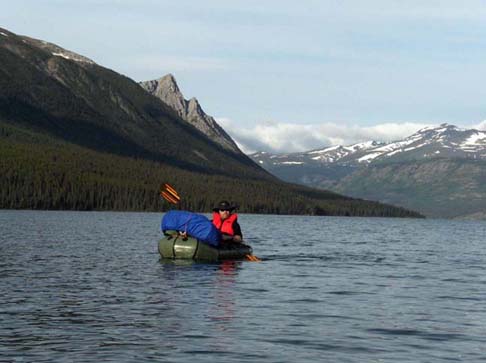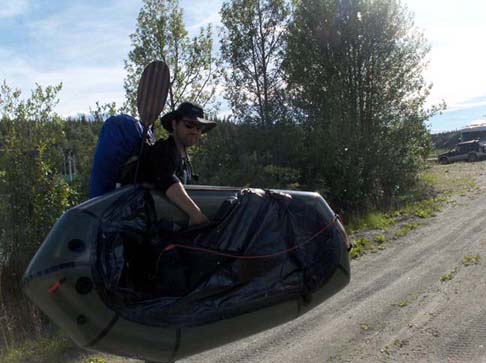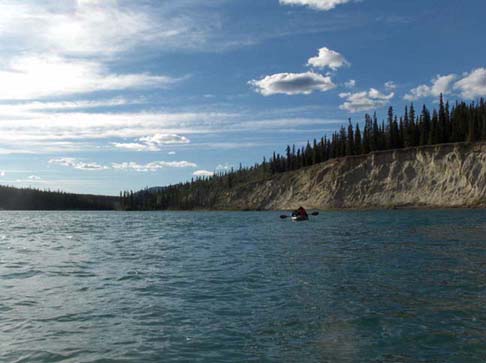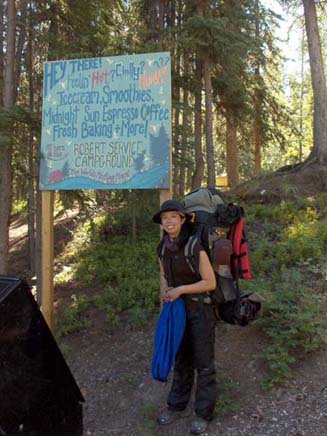Last week my girlfriend and I took our new packrafts on a 6-day, 70-mile trip from the headwater lakes of the Yukon River to Whitehorse. This is the where the gold rush stampeders reached the end of the Chilkoot Trail and built their makeshift “floating coffins” for the long trip down the Yukon River to the Klondike gold fields. We rode the Alaska state ferry from Juneau to Skagway, then the next day caught a scheduled bus to Carcross, Yukon. It is also possible to ride the White Pass and Yukon railroad from Skagway; a unique and scenic experience, but the bus was much cheaper.

We inflated our rafts just downstream of the railroad depot in Carcross and started paddling across Nares Lake, the first of three long lakes we would have to traverse to reach the Yukon River. After a couple of hours of paddling in calm conditions we reached Tagish Lake, which would prove to be one of our greatest challenges. After camping for the night, we attempted a mid-morning cross of Windy Arm, a long inlet on the east side of the lake, but we soon realized we had overreached. Windy Arm lived up to its name, whipping up 3-foot breaking swells with howling winds right on our nose, eventually blowing us backwards all the way to the other side of the lake, where we surfed on to a cobble beach. The winds increased even more, turning the lake into a miniature Pacific Ocean, so we rolled up our rafts and hiked about five miles down the shore to Sucker Bay (so named because many canoes have been trapped there in similar conditions).
We set our alarm for 4 am in hopes of finding calmer weather, and woke to somewhat diminished winds. We decided to hike a short distance to where the lake begins to turn northward, putting the wind essentially at our backs. From there, we literally sailed to the end of the 20-mile long lake, until we reached the outlet and the six-mile-long Tagish River. Unfortunately, the wind had increased as the day progressed, and failing to reach the river channel, we were forced to surf through breakers to the appropriately named California Beach. Picking up our rafts, we walked past a line of empty vacation cottages until we were well within the river channel, and had a peaceful float to the village of Tagish.
After a mosquito-filled night in the territorial campground, we launched into Marsh Lake, another 20-mile-long stretch of water. Our arms and shoulders were beginning to feel the effects of all the strenuous paddling, but once again the wind picked up from the south, putting it on our backs and allowing us to sail most of the way down the lake. We camped at a sandy spit on the western shore near the lake’s mid-point, sharing the space with a pair of highly annoyed arctic terns. We soon discovered the reason for their less than enthusiastic welcome; a fat, down-covered fledgling was hanging out in some sedges near the shore, eagerly waiting for the next course of an unending meal of small fish brought by its parents.

Early the next day we enjoyed a pleasant sail to the north end of the lake, where we finally entered the mighty Yukon River. The clear, glass-calm water and steady current made for a relaxing float, and we anticipated the rest of the way to be a cinch compared to the temperamental lakes – that is until I noticed a few puffs of wind rippling the surface. I welcomed the cooling breeze, as the still afternoon air was getting rather muggy. But suddenly, what was a pleasant breeze morphed into a wall of wind, right on the nose. As the river widened into a large marsh, the wind grew stronger, and a battle ensued between wind and current, building up surprisingly large standing waves. We were bystanders caught in the crossfire, paddling furiously whenever the gusts died down enough to make some forward progress. When we saw another gust coming, we pulled over to the shallows and grabbed hold of some marsh grass until the worst was over, then paddled our hearts out again. With no camping spot in sight anywhere in the marsh, we had no choice but to continue on. By the time we reached the Alaska Highway at the Lewes River bridge, we were totally exhausted from nearly 10 hours of paddling.
After a short portage around the nearby Marsh Lake Control Structure, we floated past high cliffs of Ice Age glacial silt, perforated by hundreds of holes–nests for the cliff swallows flitting about over the river in search of insects. We floated just far enough to get out of sight of the highway, stopping at the first reasonable camping spot. It was a nice, flat, flower-covered bench above a shallow riffle at the edge of the deep blue river channel. It was an inviting fishing spot, but all I was able to do was crawl into the tent and collapse on my sleeping bag.

The next morning we pushed off into the river, easily floating along with the swift current. When we stopped for lunch near another gravel riffle, I brought out my small telescoping spinning rod to see if I could supplement our rapidly dwindling food supply with a little finned protein. On my first cast I got a hit, and by the second cast had a fish on. It was an arctic grayling, not much bigger than my lure, but encouraging nonetheless. I proceeded to hook five more fish, keeping the largest two for the frying pan. I built a small fire on the gravel shore, squirted some olive oil into the pan and fried up a tidy little mess of fish, seasoned with basil, lemon pepper, and sea salt.

After lunch we floated further down the river, letting our rafts spin around in the current to enjoy the scenic panorama. As evening approached, we stopped at an inviting camping spot at a sharp bend in the river where we pitched our tent in a shady spruce grove. The next morning we began our final day of floating on the Yukon, stopping at Canyon City to check out the old ruins, then making the easy but exciting run through the swirling currents of Miles Canyon with its vertical walls of volcanic basalt, while high above at a highway overlook a bus load of tourists trained their cameras on us, following our progress.
The canyon eventually spit us out into Schwatka Lake, a reservoir which serves as the source of electricity and drinking water for Whitehorse, the capital of the Yukon Territory. At the end of Schwatka Lake we beached near the dam, where we picked up our rafts and made the quick portage past the spillway then launched back into the river for the short run to Robert Service Campground at the outskirts of downtown Whitehorse. After a week of rationing our trail food, we had no trouble filling up at Whitehorse eating establishments serving Alaska halibut and chips, Middle Eastern, and Jamaican fare. A couple of days back in civilization and we were ready for our trip back home. Our paddling route had taken nearly a week to complete; our bus trip from Whitehorse back to Carcross only took about one hour!

I recommend this trip to those who would like to try extended flatwater paddling in a packraft. The route has a strong wilderness feel (we were alone for almost the whole trip), but there are several road access points along the way if for some reason you need to bail out. Just be mindful of local wind and weather patterns, be prepared to paddle for several hours a day and occasionally roll up the rafts and walk, and don’t go any further from shore than you are willing to swim in very cold water. For more information on the route you can check out the book “Klondike Trail: The complete hiking and paddling guide” by Jennifer Voss.